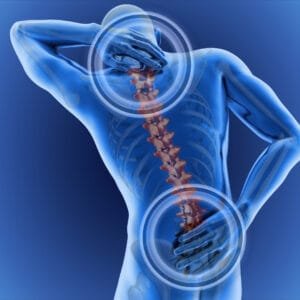Back Pain: Causes, Symptoms, and Treatment
Back pain is one of the most common health problems worldwide, affecting people of all ages. It can range from a mild ache to severe, debilitating discomfort, impacting daily activities and quality of life. Understanding the causes, symptoms, and effective treatments for back pain is essential for managing this widespread issue.



What is Back Pain?
Back pain refers to discomfort or aches in the muscles, nerves, or bones of the back. It can occur in different regions:
- Upper back pain: Involving the shoulders and thoracic spine.
- Lower back pain: The most common type, affecting the lumbar region.
Back pain may result from injuries, medical conditions, or lifestyle factors and can be acute (short-term) or chronic (lasting more than three months).
Causes of Back Pain
Back pain can have various origins, categorized into mechanical issues, medical conditions, and lifestyle factors:
1. Mechanical Causes
- Muscle Strains:
- Overuse, heavy lifting, or sudden movements can strain back muscles.
- Herniated Disc:
- When a spinal disc slips out of place, it can compress nearby nerves.
- Degenerative Disc Disease:
- Wear and tear on spinal discs as part of aging.
2. Medical Conditions
- Arthritis:
- Osteoarthritis can affect the spine, leading to stiffness and pain.
- Sciatica:
- Compression of the sciatic nerve causing radiating pain down the leg.
- Spinal Stenosis:
- Narrowing of the spinal canal, putting pressure on nerves.
- Osteoporosis:
- Weakening of bones, increasing the risk of fractures.
3. Lifestyle Factors
- Poor Posture:
- Slouching or sitting for long periods strains the back.
- Obesity:
- Excess weight increases stress on the spine.
- Lack of Exercise:
- Weak muscles provide less support for the spine.
Symptoms of Back Pain
The symptoms of back pain can vary depending on its cause and severity:
Common Symptoms
- Dull, aching pain in the back.
- Stiffness, especially in the morning.
- Difficulty standing up straight or moving.
Severe Symptoms Requiring Medical Attention
- Pain radiating down the leg (sciatica).
- Numbness or tingling in the back, legs, or feet.
- Loss of bladder or bowel control (may indicate a medical emergency like cauda equina syndrome).
- Unexplained weight loss or fever accompanying back pain.
Diagnosis of Back Pain
A healthcare provider can determine the cause of back pain using a combination of medical history, physical examination, and diagnostic tests:
1. Medical History and Physical Examination
- Identifying the duration, severity, and location of pain.
- Assessing mobility, posture, and range of motion.
2. Imaging Tests
- X-rays:
- Detect bone issues like fractures or arthritis.
- MRI or CT Scans:
- Provide detailed images of soft tissues, including discs and nerves.
3. Lab Tests
- Blood tests to identify infections or inflammatory conditions like rheumatoid arthritis.
Treatment for Back Pain
The treatment for back pain depends on its cause and severity. Options include home remedies, medications, physical therapy, and medical interventions.
1. Home Remedies for Back Pain
- Rest:
- Avoid activities that aggravate the pain, but avoid prolonged bed rest.
- Ice and Heat Therapy:
- Apply ice packs for acute injuries and heat packs for muscle stiffness.
- Stretching and Strengthening:
- Gentle yoga or back-strengthening exercises can reduce stiffness and pain.
2. Medications for Pain Relief
- Over-the-Counter Pain Relievers:
- Ibuprofen or acetaminophen for mild to moderate pain.
- Muscle Relaxants:
- For muscle spasms.
- Prescription Medications:
- Stronger pain relievers or anti-inflammatory drugs for severe cases.
3. Physical Therapy and Rehabilitation
- Stretching Exercises:
- Improve flexibility and strengthen core muscles.
- Postural Training:
- Helps correct poor posture and align the spine.
4. Interventional Treatments
- Corticosteroid Injections:
- Reduce inflammation around nerves or joints.
- Nerve Blocks:
- Provide temporary pain relief by numbing affected nerves.
5. Surgical Options
- Recommended for severe cases, such as herniated discs or spinal stenosis that do not respond to conservative treatments:
- Discectomy: Removal of a herniated disc.
- Spinal Fusion: Fusing vertebrae to stabilize the spine.
Preventing Back Pain
Preventive measures can help reduce the risk of back pain:
1. Maintain Good Posture
- Sit with your back straight and feet flat on the floor.
- Use a chair with proper lumbar support.
2. Exercise Regularly
- Strengthen core muscles to support the spine.
- Incorporate low-impact activities like walking, swimming, or yoga.
3. Lift Properly
- Bend at the knees, not the waist, when lifting heavy objects.
4. Maintain a Healthy Weight
- Reduces pressure on the spine and joints.
5. Ergonomic Workspace
- Use adjustable desks and chairs to minimize strain during long work hours.
Complications of Back Pain
If untreated, back pain can lead to complications that affect overall health and quality of life:
- Chronic Pain:
- Persistent discomfort impacting physical activity and mental well-being.
- Mobility Issues:
- Reduced ability to perform daily tasks.
- Dependency on Medications:
- Prolonged use of painkillers may lead to side effects or addiction.
- Mental Health Problems:
- Anxiety or depression associated with long-term pain.
FAQs about Back Pain
1. What causes sudden lower back pain?
Sudden lower back pain is often caused by muscle strains, lifting heavy objects, or improper movements.
2. Can poor posture lead to back pain?
Yes, poor posture places additional stress on the spine and muscles, leading to pain and stiffness.
3. When should I see a doctor for back pain?
Consult a doctor if back pain persists for more than a few weeks, worsens over time, or is accompanied by severe symptoms like numbness or bowel problems.
4. What exercises are good for back pain?
Gentle yoga, walking, swimming, and back stretches are effective for alleviating pain and improving flexibility.
5. How can I prevent back pain while working from home?
Set up an ergonomic workspace, take frequent breaks, and practice good posture.
Conclusion
Back pain is a prevalent condition that can affect individuals of all ages. While most cases resolve with rest, home remedies, and lifestyle changes, persistent or severe pain may require medical evaluation and treatment. By adopting preventive measures like regular exercise, proper posture, and a healthy lifestyle, you can reduce the risk of back pain and maintain a strong, healthy back. If symptoms persist or worsen, consult a healthcare provider for a personalized treatment plan.
